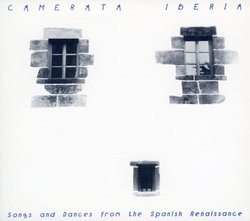Superb musical glimpse at an important corner of history.
B. Marold | Bethlehem, PA United States | 09/21/2005
(5 out of 5 stars)
"`Danzas Medievales Espanolas' and `Calamus, The Splendour of Al-Andalus' are both performed by the Eduardo Paniagua Group which, I believe, is based in Spain. Both albums were recorded at the Monasterio de la Santa Espina, Valladolid, Espana and both ensambles of musicians are lead by Eduardo Paniagua, although there is some difference in the personnel between the two albums.
Andalucia is the most southwesterly province in Spain and therefore the one under control of the Moors for the longest time. The latter of the two albums specifically offers us music of `Arab-Andalusian Music of the 12th to the 15th centuries', after which the Moors were kicked out of Spain by Isabella and Ferdinand. As I listen to this specifically Arab music, I hear virtually nothing which tells me that it is music performed in Spain. It is certainly old, but not too different from the Arab music I hear on Sunday's on my local NPR radio station. You can almost hear the influences of the Levant which are shared by both Arab and Israeli musical styles. I am constantly looking around to find the sources of all the clicks and rattles as I do my gardening with Walkman in full throat. Turns out, it is all from the rich family of Middle Eastern percussion instruments on this album. Looking at the names of the tracks, they too all seem to be in a Latinized spelling of a Middle Eastern language.
The first album of Medieval dances with largely the same instruments and a very similar ensemble sounds quite different. This music is quintessentally European Renaissance, with strong similarities to other recordings of Renaissance music by French, English, Dutch, German, and Italian influenced performers. The titles to these pieces have a much more pronouncedly Spanish look to them. Some even seem to be titled in Latin, which seems odd, but maybe not that odd, as the two strongest influences on popular music through the ages is dance and liturgical (nee gospel) music. So, one shouldn't be too surprised to see a little Kyria slip into the vernacular.
One thing which really impresses me is that while western music has changed so much over the last 6 centuries, the Arab music sounds so much like it does today, and yet in the 15th century, it sounds a lot more sophisticated than the native European music.
I highly recommend both albums, but if you are really on the lookout for `something completely different', go for the Arab music of Al-Andalus!.
"
Synergy of sound and culture
12/30/2003
(5 out of 5 stars)
"This recording stands out as the best in a growing range of CD's of medieval Iberian music, which mixes Arab, north African, and European themes. The music itself is spellbinding. There's nothing else quite like these songs' melding of sounds and tempos from early European and African/Arab instruments. But it's also true that Paniagua and friends are super interpreters, setting a wide variety of moods that all get resolved by the end of the CD, for a satisfying listen. The repetory artists get from this period is both rich and overplayed--the common appearance of the Red Book themes in recent recordings a case in point. That makes intelligent interpretation crucial. The distinction of Paniagua's group is their truly new renditions of common tunes with the addition of deep skill in contemporary north African music. Purists might look askance at the way the CD intersperses modern Bedouin and Arab instrumentals with the ancient Andalusian songs. Yet many of the old songlines that migrated into Spanish Muslim society never got transcribed, certainly not in later European texts, making modern plugs essential to a complete recording. Now, in other hands, it would be Orientalist of the artists if they were suggesting that north African music hasn't changed significantly in over seven hundred years. But I think the group decided that some continuities--inside north African music, among Meditteranean musics--(1) merit being recognized and argued today, and as a result (2) give hope for building conversations that defy seemingly irreconcilable divisions of Africa from Europe, Christianity from Islam.So what might make this CD stand out best is its subtle take on the culture, or politics, of this genre of recordings. Paniagua's group does far and away the best job I've seen of explaining, through the music itself, why today's north African and Spanish artists want to make it come alive again. National leaders and major media like to tell us that Islam and Christianity repel like opposed magnets, that they form separate "civilizations" that inevitably "clash." This music suggests that history tells a different story. More importantly, the effort the artists take to play it suggests that the present also deserves a different story. The music is both harmonious and dissonant, suggesting both the troubles and the promise that emerge in a truly heterogenous society, especially when people embrace a mixed culture. I get inspired to do that work when I hear how it happened in the past, or how people try to create new links in the present."


 Track Listings (17) - Disc #1
Track Listings (17) - Disc #1